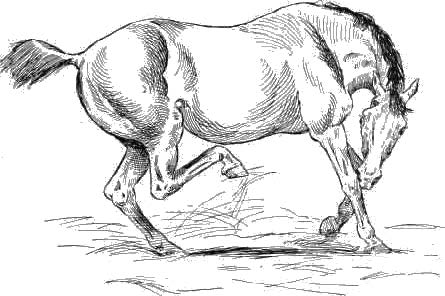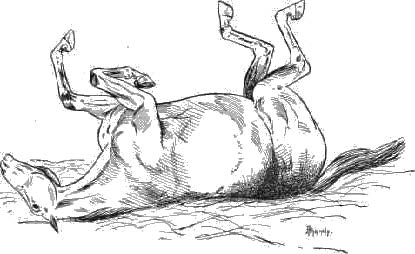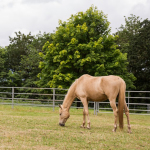Many horse owners consider the word colic a scary one and for some it brings heart breaking memories. Equine medicine has come a long way in understanding, treating and reducing the risk of colic, but it still is on the top of the list of medical emergencies and the number one cause of death in horses. Colic is not a single disease, but a symptom or sign of one. It is defined as abdominal pain and it can be caused by any organ in the abdominal cavity (liver, spleen, urinary tract, reproductive tract or gastrointestinal tract). The vast majority of colic’s in horses are caused by problems in the gastro intestinal (GI) tract.
 Colic symptoms include:
Colic symptoms include:
- Kicking at the belly (unless the horse is bothered by flies)
- Biting at the flank or turning to look at flank/belly
- Lip curling (other than sexual interest)
- Laying down repeatedly +/ pacing
- Playing with or nosing at water without drinking
- Grunting or groaning mainly while laying down
- Pawing
- Rolling and/or thrashing (this is a sign of severe pain)
- Change in manure
- Increased or lack of abdominal sounds
- Excess gas production
- Abnormal posture (stretching out, posturing to urinate, dog sitting)
- Abnormal gum color (pale, red, dark or not regaining color fast when pressed upon)
- Nonspecific signs of distress (decrease or absence appetite, depression, inappropriate sweating, elevated heart rate, rapid breathing)
Colic symptoms tend to be nonspecific and a veterinary exam is warranted to determine the cause of the problem. If you suspect that your horse has signs of colic, contact your veterinarian. Remove all food, leave some water unless drinking excessively. Keep the horse in an area where he/she can be watched closely. Allow your horse to rest or walk him/her around if continually rolling or in danger of getting hurt. You need to do your best to stay calm and safe.
DO NOT administer any medications or substances to a colicky horse without first consulting with your veterinarian. NEVER pass any kind of tube into the horse’s stomach or insert anything into the horse’s rectum. DO NOT walk your horse for hours expecting this to resolve the colic. Simple colics may resolve on their own after 30 minutes or so of walking. Anything longer than that requires medical intervention.
Before contacting your veterinarian make sure to obtain as much information as possible about your horse’s condition. These include:

- Severity and duration of colic signs
- Heart rate
- Respiratory rate
- Rectal temperature
- Gum color
- Hydration status: gum moisture, skin tent
- Capillary refill time: normal is less than 2 seconds
- Bowel sounds
- Manure: amount and character
- Recent changes
- Medical history
Veterinary evaluation of the colicky horse:
- Complete history (feeding, water intake, deworming program, vaccination schedule, recent changes, etc.)
- Complete physical exam
- Rectal palpation (this one may not be performed if is not safe for the horse, handler and the veterinarian)
- Nasogastric intubation (stomach tube): since horses are unable to vomit it is imperative to check for any presence of reflux (excess fluid) in order to avoid stomach rupture.
- Assessment of response to treatment
- Blood work, evaluation of peritoneal fluid (belly tap) and ultrasound to evaluate abdominal organs can be performed in more complicated cases of colic.
Types of colic:
- Intestinal dysfunctions: Most common category and usually respond to medical treatment. These include: spasmodic or gas colic, decreased motility and impaction (blockages may occur due to parasites, dry backed up ingesta or enteroliths).
- Intestinal accidents: These are less frequent and most likely require surgical intervention. Include: twists, entrapments, infarctions, emboli and clots.
- Inflammation or ulceration: Can be caused by stress, medications, infections or parasites. Medical treatment tends to be required.
Medical treatment includes:
- Painrelievers: Banamine is the most commonly used NSAID for colic. It is available in liquid and paste form. The liquid form should only by administered intravenously. Intramuscular Banamine can predispose your horse to a life threatening Chlostridial myositis.
- Fluid therapy (via nasogastric tube or intravenous)
- Laxatives
- Sedatives
If colic signs can not be managed with medical treatment surgical intervention is warranted. Fever is the only sign that will make us avoid abdominal surgery.
Horses are predisposed to colic due to the anatomy and function of their digestive tract. Every case of colic is not avoidable, but good management practices can play a key role in prevention.
Guidelines for reducing the risk of colic from the American Association of Equine Practitioners:
- Establish a daily routine – include feeding and exercise schedules – and stick to it.
- Feed a high quality diet comprised primarily of roughage.
- Avoid feeding excessive grain and energy-dense supplements. (At least half the horse’s energy should be supplied through hay or forage. A better guide is that twice as much energy should be supplied from a roughage source than from concentrates.)
- Divide daily concentrate rations into two or more smaller feedings rather than one large one to avoid overloading the horse’s digestive tract. Hay is best fed free choice.
- Set up a regular parasite control program with the help of your equine practitioner.
- Provide exercise and/or turnout on a daily basis. Change the intensity and duration of an exercise regimen gradually.
- Provide fresh, clean water at all times. (The only exception is when the horse is excessively hot, and then it should be given small sips of lukewarm water until it has recovered.)
- Avoid putting feed on the ground, especially in sandy soils.
- Check hay, bedding, pasture, and environment for potentially toxic substances, such as blister beetles, noxious weeds, and other ingestible foreign matter.
- Reduce stress. Horses experiencing changes in environment or workloads are at high risk of intestinal dysfunction. Pay special attention to horses when transporting them or changing their surroundings, such as at shows.
